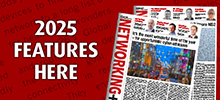08 July 2021
Networking+ caught up with the biggest players in the critical communications space to get their views on the current critical comms space and the technology that makes it possible
What are key critical comms issues, considerations for the UK marketplace?

Tony Gray, chief executive, TCCA
Tony Gray, chief executive, TCCA: The UK is currently working to replace the Airwave TETRA network used by all the emergency series. Whilst still functional and still very good for voice communications, the decision to move away from a narrowband network to a standards-based 4G LTE network is aimed at allowing the seamless integration of voice and broadband data, greater choice of devices and a clear roadmap forward as technology evolves. A system more aligned with the MNO model should allow for greater competition in the provision of the network aspects, by separating it away from the functionality provided to run over the top. By splitting the functionality and allowing competition the costs can be reduced.
The issues from a future perspective are what proven standards-based solutions exist and currently this has yet to be fully demonstrated in a live operational environment. The parts for a full solution exist, but the ability to bring them together to form a single system that provides all the functionality that current TETRA systems offer has yet to be seen. The other main issue is the need to try and bring the various parts of a new system together at the same point in time. This is made far harder as the parts, such as devices, follow much more closely the refresh cycles of modern smartphones, so have a lifespan much more in the three-four year period, rather than the seven-nine year lifespan of a TETRA device. This means that the device will need to change during development, testing and the transition to live service, with every change of device requiring full regression testing, using up significant parts of the device lifespan. This same constant refresh cycle will be seen across many of the parts of the overall system. On the upside this constant refresh cycle brings greater functionality with every release.

Sean Fitzgerald, head of EMEA solutions, marketing at Motorola Solutions
Sean Fitzgerald, head of EMEA solutions marketing at Motorola Solutions: Even though it’s a mature market, critical communications technology is continually evolving. The UK mission-critical market is constantly adapting to changing demands and challenges, such as operations becoming increasingly data-driven. Over the past year, the pandemic also accelerated the need for solutions that facilitate remote working as social distancing regulations prompted closure of many workspaces. For many, this meant a greater focus on collaboration and productivity, including applications that make individual’s and team’s workflows more efficient, and highlighted the need for simple communication using voice, video and data.
This, in turn, led to wider adoption of cloud-based solutions for data sharing and storage. A collaborative ecosystem enables more seamless end-to-end workflows, helping teams and individuals across multiple sites communicate with voice and access data. Reliable, accessible solutions are essential features for sharing secure, robust mission-critical communications.
Cellular or TETRA – which best fits specific user groups?

Peter Hudson, chief technology officer, Sepura
Peter Hudson, chief technology officer, Sepura: TETRA networks are specialist networks delivering mission critical communications services, with specific feature sets that have evolved and improved over time. These requirements are based on extensive user interactions, understanding how people interface with technology whilst undertaking their role.
TETRA networks are designed to provide a high level of inherent resilience and redundancy in their architectures. The networks are dimensioned to provide a specific grade of service at peak load to the user groups they serve; if peak demand is overreached, calls are queued, rather than dropped.
Cellular networks are designed and operated to meet a different set of criteria, user needs and operational efficiency. These demands are often conflicting to those of a mission critical user. Cellular networks can be configured to fit the needs of critical users, but this can be a tradeoff to commercial use. Private or national networks can be configured to the needs of mission critical demands with full end to end integration, appropriate terminals or devices and compliance to appropriate (3GPP) interface protocols and standards.
In practice the split between cellular and TETRA is not so black and white. Hybrid or mixed networks provide the best of both worlds, delivering what they are best designed for. Broadband or LTE networks are inherently good at delivering data services, where the response and reliability are not mission critical, whereas TETRA is proven to provide reliable mission critical voice communications. Use and integration of both networks delivers the gold standard service with the opportunity to explore and benefit from a whole range of new data applications. Broadband technology is complementary to narrowband - it does not necessarily replace it (certainly in the near to mid-term) but enhances what can be offered to users.
The choice between cellular and TETRA is based upon user needs.
Tony Gray, chief executive, TCCA: As the question suggests, it is very much a matter of the particular types of users and their needs. Cellular is designed for consumer subscribers, supporting one-to-one calls with relatively slow set up time, can have coverage issues in some cases and may be unreliable at times of peak demand or overload. Communications for TETRA users are mission critical and may even be lifesaving. If the user need is for reliable, resilient, secure group communications with sub-0.5 second call set up and all the other features well known, proven and trusted by users, then the choice has to be TETRA.
Which three requirements must mission critical comms meet?
Peter Hudson, chief technology officer, Sepura: Reliable coverage – the network must provide reliable communications, always available in all circumstances. Quality of service and performance KPIs must be sustained to ensure successful operations, both within the network coverage and when network is not available. Direct mode operation is a key operating requirement for most mission critical users who need to be able to rely on communications however the network status changes, planned or unexpected.
Robust design – the devices must be sufficiently robust to keep working in adverse weather conditions – whether hot, cold, or wet – or adverse environmental conditions, for example in dusty, salty or dirty locations. The devices must also be tough enough to stand repeated cycles of deployment with varied users, withstand heavy kicks, drops and intensive use.
Practicable usability -– audio must be intelligible, loud and clear so that information and instructions are heard first time, every time. This includes whilst operating in noisy, dangerous or busy environments. This intelligibility is enhanced by a portfolio of mission critical quality proven, accessories allowing users to use devices in a manner that supports their daily operational needs, for example eyes free usage and easy to access using gloves and other protective equipment.

Jeremy Wastie, head of public sector sales, MLL Telecom
Jeremy Wastie, head of public sector sales, MLL Telecom
1. Capacity – reliable symmetric performance – more and more data is going “upstream” rather than simply being down loaded from the cloud.
2. Resilience - high SLAs with resilient fall back – a 10 minute outage can be business critical or even life threatening in Critical National Infrastructure. Networks need to be designed with multiple layers.
3. Secure – end to end security of data.
Tony Gray, chief executive, TCCA: There are more than three, but top of the list typically come reliability, resilience and security, wherever and whenever users need to operate. Mission critical communication users often operate in dangerous situations in challenging environments, so their communication services need to be available always and everywhere – it is impossible to predict when and where incidents take place. Good geographical radio coverage (both on network and off network) is essential for high service availability. The quality of communication services needs to match user requirements, seamlessly supporting users’ operational processes and supporting user needs depending on the incident and the operational processes.
There are some aspects of spectrum management where government can support the deployment of a 4G LTE network, for example ensuring some spectrum is authorised for use above 500ft, to assist with the deployment of Air to Ground networks.
What’s the biggest problem facing critical communications today?
Jeremy Wastie, head of public sector sales, MLL Telecom: Consistent high capacity services across the UK. This is being addressed by the emphasise on full fibre networks across the UK both from the independent new players but also from the established telcos who are investing their own and government funds in developing full fibre service and switching off the long-serving but historic copper networks. Closely behind we will see the growth in 5G services from the mobile operators, but these will rely on those full fibre networks to deliver the necessary backhauls for 5G services to really fly.
Tony Gray, chief executive, TCCA: It’s not a problem unique to critical communications, but budgets and priorities are a universal issue faced by many users in all walks of life who need investment in systems and technology to make their lives and work more efficient, effective and safe. Although the most important area of communications, the mission critical world is very small compared to the consumer market. Business cases based on volume cannot compete with the consumer landscape, so while there is a huge amount of innovation in our sector, only a fraction makes it to market as truly mission critical products and services. Resource is also an issue – many of the key developments in critical communications have been and are driven by committed volunteers who work for the good of society and not for the profit.
Is unified critical comms something you recommend or does it but too much additional pressure on a network?
Jeremy Wastie, head of public sector sales, MLL Telecom:
- Standard voice services e.g. MS Teams are now becoming a de facto cloud based service and can always be backed up by mobile services. Provided it is built into network design.
- Contact Centre and Emergency Command and control services should remain “standalone”.
Peter Hudson, chief technology officer, Sepura: No one technology will provide the answer to all needs, either technically or economically. To provide the range and capability of services that we can see being demanded, a range of technologies will be required to achieve this; essentially creating a network of networks.
To reduce complexity in cost and operation it is essential to define carefully which elements need to communicate with each other, rather than a default ‘everything must interoperate with everything’ approach. A unified critical comms approach also provides a pathway to adopting new technologies or developments as they become available, ensuring the cost of change is minimised.
It is essential that stakeholders have a sure understanding of security requirements when adopting a hybrid solution. Only in this way will they be able to ensure that any end to end communication, in particular cross technology communications, is fully secure and safe from attack.
Sean Fitzgerald, head of EMEA solutions marketing at Motorola Solutions: The reliability of radio remains a key for critical communications. There is, however, significant growth in the importance of other data, including video, and subsequently a greater need for unified critical communications. Many businesses also require collaboration with other devices that their workers carry, including LTE devices and body-worn video cameras, without compromising the security or reliability of their radio voice communications.
As the use of video in critical communications becomes more important across a range of sectors, devices and software have evolved to make it simple for users of different devices to share data over networks, and store video and images in cloud-based solutions for easy, remote access.
A trusted partner for unified critical communications understands the challenges their user faces, developing solutions collaboratively with the customer that can meet and support their needs. An approach enabled by a common ecosystem of hardware and software, such as the WAVE PTX application, allows users to share voice, video, images and other data with MOTOTRBO or TETRA two-way radios, plus broadband and LTE devices at the push of a button, working seamlessly across networks for reliable communications.

What is the most unusual critical comms application you’re experienced?
Paul Ward, international sales director, Etelm: Etelm was involved in a project for biometric monitoring of military personnel. This was following a number of incidents where armed forces personnel died or became seriously unwell whilst on exercises or during remote tactical deployments. The system involved monitoring all key cardio and biometric information of troops in the field, using Bluetooth data to the personal mobile device which was then transmitted in real-time over our critical communications network. Even core body temperature could be monitored using a capsule that could be safely swallowed, sending Bluetooth data instantly over the network to the command centre. Alarms would be triggered based on specified parameters so any health concerns could be responded to quickly.

Robert Nitsch, Frequentis vice president public safety
Robert Nitsch, Frequentis vice president public safety: Unusual applications are in the eye of the beholder. By definition, emergencies are unexpected events that often require immediate action. However, there are also planned events that put an unusual level of strain on resources or accentuate critical communication needs; for example events such as the Olympics or the G7 summits, both of which Frequentis has been able to support with its critical communication solutions, already implemented around the globe.
The need to temporarily scale up operations, to handle the surge in communication demand, to manage such event, and to be able to seamlessly patch different communication technologies (analogue and digital radio, telephony), to safely reach and coordinate emergency personnel to save lives, protect property and maintain public order is vital. With a web-based front-end our 3020 LifeX solution is capable of providing access to an operator working position from anywhere, meaning dispatchers can manage emergency incidents from any mobile device or location. This was also very beneficial during the pandemic where extra control room resources were needed to manage increased caller demand.
In what situation do you think the enterprise user should consider a critical comms solution?
Paul Ward, international sales director, Etelm: There is a big demand from private critical communications users for broadband mobile data services. This can never be achieved using traditional narrowband PMR/LMR services – TETRA can offer secure voice and low speed data but for users wishing to use high speed mobile data applications LTE is definitely the best choice. As LTE voice standards evolve the option to utilise the best features of TETRA for mission critical voice and LTE for high speed data services is ideal as the industry moves towards full mission critical LTE.
Robert Nitsch, Frequentis vice president public safety: There are many enterprise customers with critical communication needs, for example airports, and utilities There is no reason why they should not consider the same solutions as Emergency Services, especially when they are available as a software as a service (SaaS) model. Often it is just the assumption that Emergency Services systems are bespoke and therefore too expensive.
The Frequentis multimedia communication platform 3020 LifeX, for telephony and radio dispatching, is unique and was especially designed and built for current and future communication demands. It is able to support all types of communication methods and display those in an easy to use irrespective of new media and associated communication features, such as ESN (MCX) and NG999, nation-wide communication solutions, integration of AI services or SaaS.










